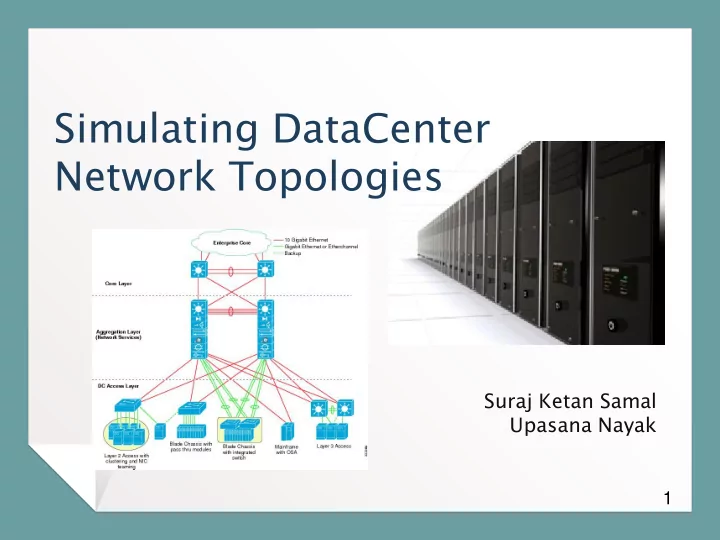

Simulating DataCenter Network Topologies Suraj Ketan Samal Upasana Nayak 1
Agenda ■ Data Center Networks (DCN) ■ Project Proposal (Our Work) ■ Network Topologies & Properties ■ Simulation using NS-3 ■ Conclusion and Future Work 2
Data Center Networks(DCN) ■ A pool of interconnected resources that serve the internet. ■ Recent years have seen huge growth in data transfer especially due to A Google Data Center multimedia, big-data and Courtesy : http://www.cse.wustl.edu/~jain/cse570-13/ftp/m_03dct.pdf high speed internet. ■ Projected growth is ~23% per year ■ Managing data is inevitable and extremely challenging. Cisco Global Cloud Index, 2013-2018 3
DCN – Overview & Challenges ■ Usually consists of three layers – core , aggregation and access ■ Nodes are connected using a interconnection network topology like FatTree , Flattened Butterfly or DCell ■ Topology is an important factor responsible for the challenges Important Challenges 4
Project Proposal (Our Work) ■ Study and evaluate existing data center topologies (FatTree, Flattened Butterfly, BCube, Dcell, FiConn and HyScale). ■ Simulate on ns-3 tool under various traffic scenarios. ■ Design and simulation of a new-topology. 5
Important Topologies ■ Flattened ButterFly ■ FatTree ■ BCube ■ HyScale 6
Topologies – Important Properties Topology Servers Diameter FatTree /4 k+1 (n= number of groups/pods) BCube (n = number of 4 servers connected in basic unit, k= recursion depth) HyScale (a = number of 4k+2 servers connected at each node, k= recursion depth, T = number of nodes in base model) 7
Topologies – A Comparision ■ FatTree ■ Flattened ButterFly ■ Average disjoint paths ■ Average Hop Count 8
Ns-3 : Network Simulator ■ Simulation tool that supports scripts in C++ or python. ■ Uses Netanim as a visualizer, but other tools can be used as well ■ Direct support for pcap trace files, xml outputs and plotting ( gnuplot ) ■ Conceptual design still the same as ns-2, but capability less that ns-2 9
Ns-3: Architecture and an Example ns-3 Architecture An Example Topology 10
DCN Simulation Setup Simulation Fat-Tree BCube HyScale Parameters Simulation Time 100sec 100sec 100sec PacketSize 1024bytes 1024bytes 1024bytes DataRates 1Mbps 1Mbps 1Mbps between switches DataRates 1000Mbps 1000Mbps 1000Mbps between switches and hosts Communication Random selection Random selection of Random selection of of two hosts and two hosts and two hosts and Pattern sending data sending data sending data between them between them between them Traffic Flow Exponential Exponential Exponential Random Random Random Pattern Routing Protocol Nix-vector(ns-3) Nix-vector(ns-3) Nix-vector(ns-3) Animator NetAnim NetAnim NetAnim Variable n varied (2-12) k=2, n varied(2-12) a=2, T=8, k varied from (1-3) parameter(refer to Slide 7) 11
DCN Simulation: Results Observed Average Throughput and Average Delay with exponential random traffic pattern. 12 Observed Packet loss with exponential random traffic pattern.
DCN Simulation: Observations Simulated Fat-Tree and BCube topologies based on existing implementations. Analysis and interpretation of results are still in progress. Using ns-3 tool seemed complex since it's architecture has been designed to support simulation of new topologies and protocols. 13
Future Work ■ Complete simulations for other topologies (DCell, HyScale II and FiConn) and compare them. ■ Simulate topologies for other parameters (other types of traffic, fault-tolerance and bisection- bandwidth) ■ Extend ns-3 capabilities to support optical networks 14
References [1] Cisco Global Cloud Index: Forecast and Methodology, 2013 – 2018. Retrieved from https://www.cisco.com/c/en/us/solutions/collateral/service-provider/global- cloud-index-gci/Cloud_Index_White_Paper.pdf [2] Bilal, Kashif, et al. "Quantitative comparisons of the state ‐ of ‐ the ‐ art data center architectures." Concurrency and Computation: Practice and Experience 25.12 (2013): 1771-1783. [3] Bilal, Kashif, Samee Ullah Khan, and Albert Y. Zomaya. "Green Data Center Networks: Challenges and Opportunities." Frontiers of Information Technology (FIT), 2013 11th International Conference on. IEEE, 2013 [4] Saha, S., Deogun, J. S., & Xu, L. (2012, June). Hyscale: A hybrid optical network based scalable, switch-centric architecture for data centers. InCommunications (ICC), 2012 IEEE International Conference on (pp. 2934- 2938). IEEE. 15
References [5] D. Wong, K.T. Seow, C.H. Foh and R. Kanagavelu , “Towards Reproducible Performance Studies of Datacenter Network Architectures Using An Open- Source Simulation Approach”, Proceedings of the IEEE Global Communications Conference (GLOBECOM’13), December 2013, Atlanta, GA, USA. [6] NS3-manual. At https://www.nsnam.org/docs/release/3.11/manual/ns-3- manual.pdf [7] NS3-Tutorial. At https://www.nsnam.org/docs/release/3.22/tutorial/singlehtml/ [8] NTU-DSI-DCN Project. At http://ntu-dsi-dcn.github.io/ntu-dsi-dcn/ [9] Poor man’s tool to support Computer Networking. At www.netkit.org 16
Questions ? 17
Recommend
More recommend